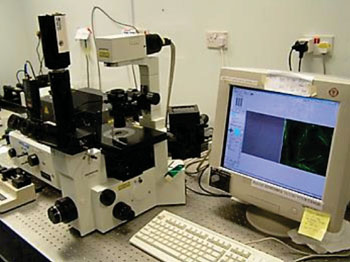Culture of Cancer Cells Predicts Response to Therapy
By LabMedica International staff writers
Posted on 16 Dec 2015
Circulating tumor cells are considered as surrogate markers for prognosticating and evaluating patient treatment responses and a novel technique has been developed to efficiently culture clusters containing circulating tumor cells (CTCs) in 14 days.Posted on 16 Dec 2015
These CTCs appear during the early stages of tumor progression as single cells or cell clusters and exhibit a partial or complete epithelial–mesenchymal transitioned phenotype and these cells may later colonize distant organs and develop into clinically detectable metastases.

Image: The Olympus Fluoview confocal microscope (Photo courtesy of National University of Singapore).
A team of scientists led by those at the National University of Singapore (Singapore) obtained 226 blood samples from 92 breast cancer patients. Sixteen healthy volunteers were also recruited to provide control blood samples for validation of culture assay specificity. Whole blood was lysed with red blood cell (RBC) lysis buffer for three to five minutes with gentle mixing, centrifuged to remove plasma and lysed RBC fragments. Each processed 10 mL of whole blood sample was split into four and each 2.5 mL sample seeded into separate 60-mm patterned dishes.
Clusters of CTCs were characterized cultured in laser-ablated microwells and cell sorting was performed with spiral inertia microfluidic biochip. Immunophenotyping of cells was carried out using primary antibodies and fluorescence microscopy. Cytospots were viewed after Papanicolaou (PAP) staining and Diff-QUIK Romanowsky staining was performed. Imaging was performed with the Fluoview FV1000 confocal microscope (Olympus; Center Valley, PA, USA) or epifluorescence microscopy (Nikon; Tokyo, Japan).
Clusters containing an increasing number of cytokeratin-positive (CK+) cells appeared after two weeks, while most blood cells disappeared with time. Cultures were heterogeneous and exhibited two distinct sub-populations of cells: “Small” (equal to or less than 25 μm; high nuclear/cytoplasmic ratio; CD45-) cells, comprising CTCs, and “Large” (greater than 25 μm; low nuclear/cytoplasmic ratio; CD68+ or CD56+) cells, corresponding to macrophage and natural killer-like cells. The small cell fraction also showed copy number increases in six target genes associated with breast cancer. The team achieved a success rate of greater than 60% in culturing CTCs from patients with metastatic breast cancer.
Lim Chwee Teck, PhD, a professor and one of the lead authors of the study said, “Being able to capture CTCs and grow them efficiently from a blood sample is a big step forward in liquid biopsy for tumor diagnosis and cancer treatment monitoring. This could potentially mean that biopsy for cancer diagnosis and prognosis could be done using a blood test, which is minimally invasive, instead of having to remove cells from the tumor itself (i.e., tumor biopsy).
Results of the blood tests could help doctors assess the best therapy options for a patient, and frequent blood tests can also be done during the course of an anticancer treatment to monitor a patient's progress during treatment.” The study was published originally online on May 6, 2015, in the journal Oncotarget.
Related Links:
National University of Singapore
Olympus
Nikon













